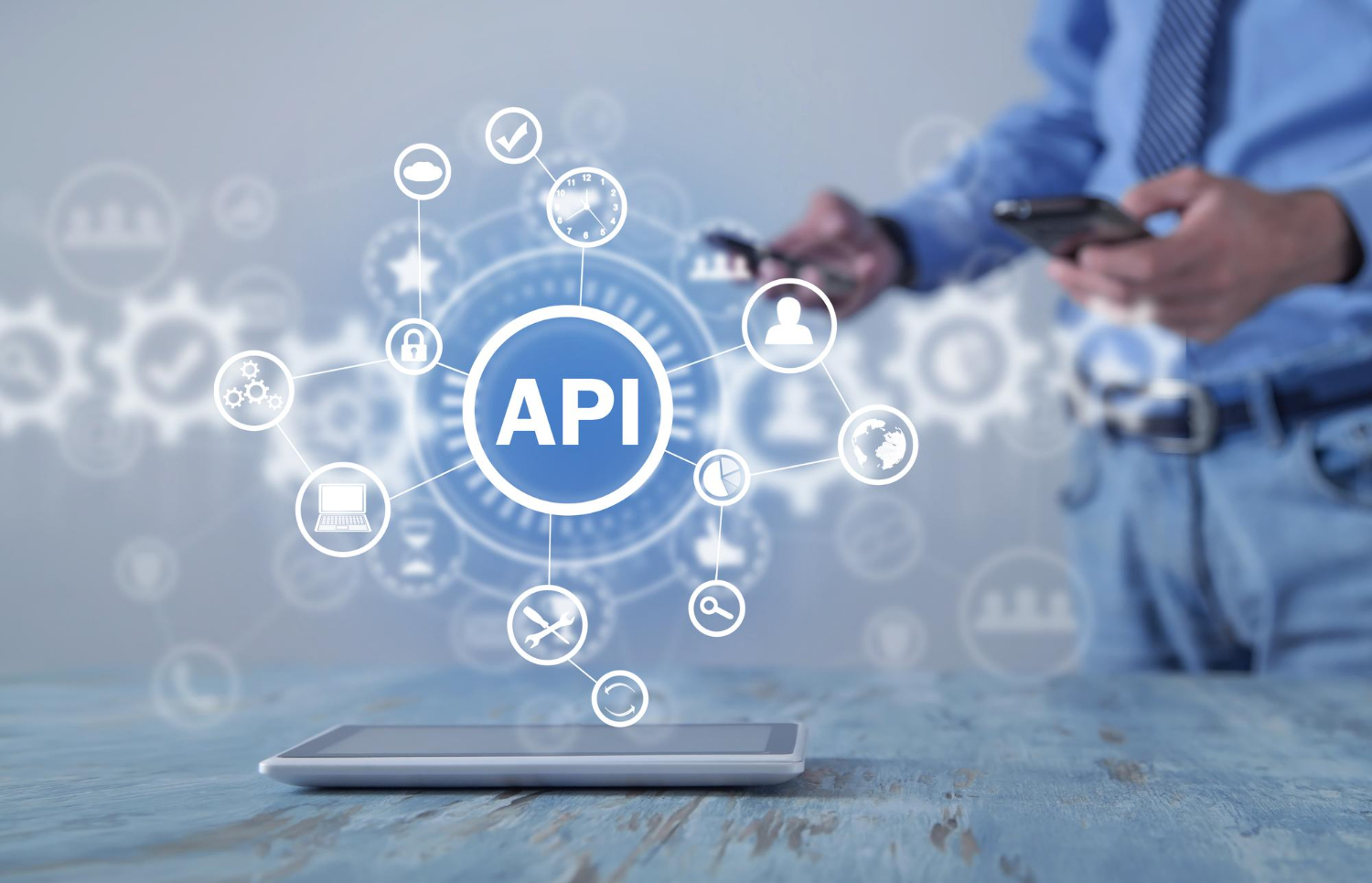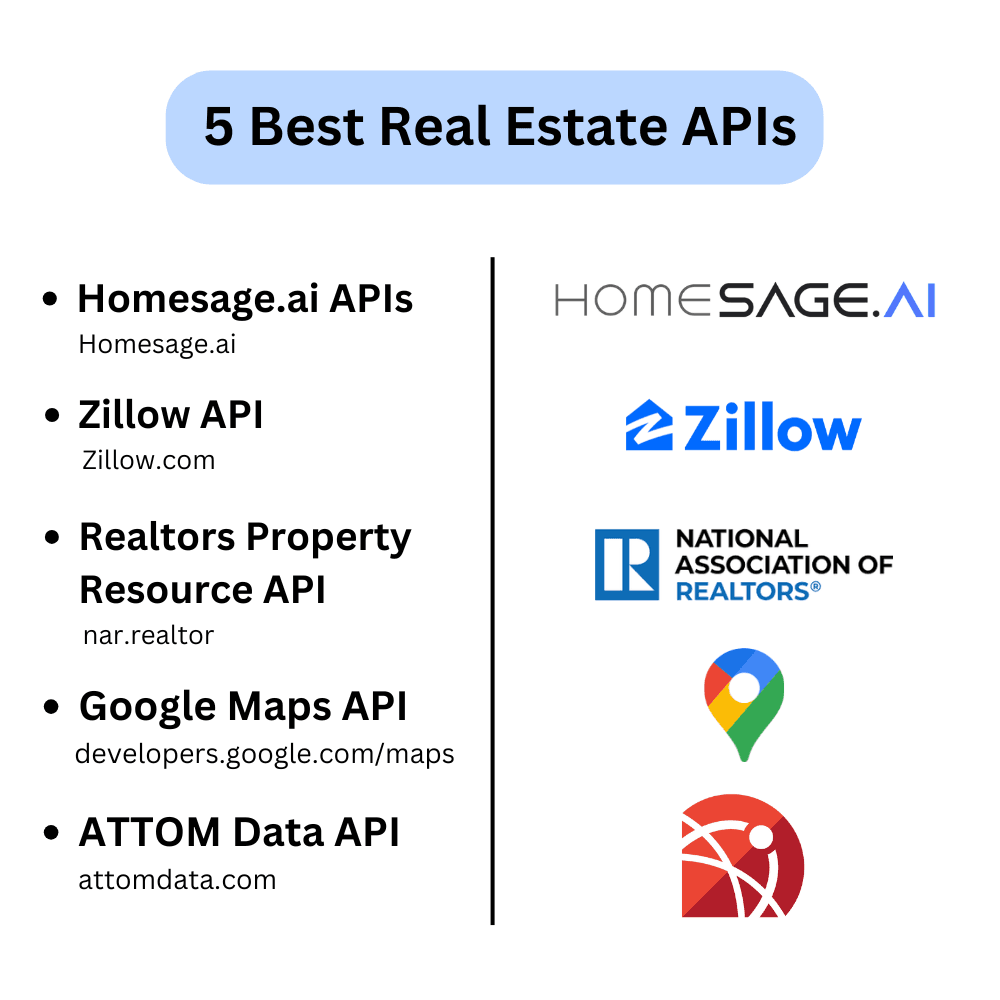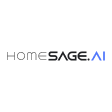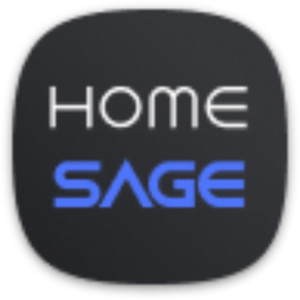The real estate industry in 2025 thrives on fast, integrated, and data-driven technology.
APIs (Application Programming Interfaces) are at the heart of this revolution, empowering developers, investors, and realtors to leverage live property data, automate workflows, and deliver seamless digital experiences.
Whether you’re building property search apps, analytics dashboards, or transaction management tools, the right API can dramatically boost your offering’s value and efficiency.
Finding the best real estate APIs requires understanding both market demands and technical capabilities. Modern proptech applications need comprehensive data coverage, reliable uptime, and developer-friendly integration options.
For an in-depth look at API-driven innovation, see the flagship guide on Real Estate APIs: 7 Best Implementation Practices by Homesage.ai, discover current market trends in the 7 Best Property Evaluation APIs in 2025, and learn how API integration supercharges business results in Streamlining Real Estate with API Integration.

What is a Real Estate API?
A Real Estate API is a set of protocols that enables apps, websites, and platforms to access property listings, market trends, valuations, neighborhood data, and more in real time.
This lets developers embed robust features such as dynamic property searches, virtual tours, and market analytics. APIs support automated workflows like valuation, mortgage pre-approvals, and property management, improving efficiency and user experience for professionals and clients alike.
The best real estate APIs provide structured access to vast property databases, enabling developers to build sophisticated applications without maintaining their own data infrastructure.
These APIs handle everything from basic property details to complex analytics like investment potential, renovation costs, and rental yield calculations.
For a developer’s perspective, see the Homesage.ai developer portal.
How Do Real Estate APIs Work?
APIs act as digital bridges, exchanging live information – property listings, sales histories, investment analytics – between platforms and databases. This real-time data flow enables apps and websites to provide comprehensive tools for property search, trend analysis, and client engagement.
For in-depth API mechanics, visit What is a Real Estate API? by Jelvix.
Modern real estate APIs utilize RESTful architecture with JSON and XML formats, supporting both on-demand requests and bulk data operations.
The best real estate APIs offer multiple access methods including property address, parcel numbers, coordinates, and ATTOM IDs, ensuring flexible integration options for different use cases.
APIs also automate processes like updating listings and sending market alerts, syncing all your property channels and reducing repetitive manual input.
Advanced real estate APIs incorporate machine learning algorithms to provide predictive analytics, automated valuations, and risk assessments that traditional data sources cannot match.
Essential Features of the Best Real Estate APIs
Data Coverage and Accuracy
The superior real estate APIs provide comprehensive coverage across multiple property types and geographic regions.
Leading APIs like Homesage.ai and ATTOM Data cover over 140 million U.S. properties, while maintaining high accuracy through multiple data verification sources.
Quality APIs aggregate data from county assessor offices, MLS systems, public records, and proprietary algorithms to ensure comprehensive property profiles.
This multi-source approach reduces data gaps and improves reliability for mission-critical applications.
Advanced Analytics Capabilities
Modern real estate applications require more than basic property information. The best real estate APIs offer sophisticated analytics, including automated valuation models (AVMs), comparative market analysis (CMA), investment potential scoring, and predictive forecasting capabilities.
Machine learning-powered APIs can provide 36-month value forecasting, risk assessments including natural disaster exposure, and detailed ROI calculations for both short-term and long-term rental scenarios.
Developer Experience and Integration
Superior APIs prioritize developer experience through comprehensive documentation, multiple programming language support, and flexible authentication methods. The best real estate APIs offer sandbox environments for testing, detailed code examples, and responsive technical support.
Integration flexibility includes support for both REST and GraphQL architectures, webhook capabilities for real-time updates, and batch processing options for enterprise-scale applications.
Rate limiting should be transparent and scalable to accommodate growing application needs.
How To Choose the Best Real Estate APIs?

When searching for the top real estate APIs, use these comprehensive guidelines:
Data Quality and Coverage Assessment
Comprehensive, current data coverage:
Prioritize APIs offering robust, up-to-date listings and market insights.
Evaluate geographic coverage, property types included, and update frequency to ensure the API meets your application’s scope requirements.
Data accuracy verification:
The best real estate APIs provide data lineage information, accuracy metrics, and confidence scores.
Look for APIs that combine multiple data sources and employ validation algorithms to minimize errors and inconsistencies.
Technical Integration Considerations
Integration & documentation quality:
Favor APIs with thorough documentation, interactive API explorers, and active support for multiple programming languages.
Quality documentation should include code samples, authentication guides, and error handling examples.
Scalability & reliability:
Ensure the API handles high data loads and offers strong uptime guarantees. Look for service level agreements (SLAs), redundancy measures, and transparent status monitoring.
The best real estate APIs provide 99.9% uptime guarantees and geographic load balancing.
For a practical walkthrough of how to access and use real estate APIs, watch our Homesage.ai guide below:
Pricing and Support Evaluation
Transparent pricing & flexibility:
Review detailed pricing structures for the best cost-to-feature ratio. Consider both per-request pricing and subscription models, paying attention to rate limits, overage charges, and volume discounts.
Responsive support:
Choose providers with robust resources, including comprehensive FAQs, developer forums, and direct technical support channels.
The best real estate APIs offer multiple support tiers and guaranteed response times for critical issues.
Before committing, consult comparison resources like 10 Best APIs in Real Estate for Software Developers, or 10 Best Real Estate APIs for PropTech in 2025.
Table 1: Best Real Estate APIs 2025 – Feature Comparison
API Provider | Property Coverage | Key Features | Pricing Range | Best For | Documentation Quality |
Homesage.ai | 145M+ US properties | AI-powered investment analytics, ROI scoring, renovation cost estimates, property insights | $70-200+/month | Investment analysis, PropTech platforms | Excellent with interactive examples |
Zillow | 150M+ US properties | Zestimate valuations, neighborhood data, mortgage integration | $0-250/month | Consumer applications, broad property search | Good with code samples |
RPR | 150M+ US properties | Professional realtor tools, CRM integration, market analytics | Free for NAR members | Real estate professionals, MLS integration | Comprehensive for members |
Google Maps | Global coverage | Interactive mapping, geocoding, location intelligence | Pay-per-use | Location-based features, mapping | Excellent with extensive examples |
ATTOM Data | 150M+ US properties | Comprehensive property records, bulk data operations | $850-2000+/month | Enterprise applications, financial institutions | Very good with detailed specs |
5 Best Real Estate APIs for 2025

1. Homesage.ai APIs
Homesage.ai leads as the most innovative API suite for real estate in 2025. Its advanced AI-driven endpoints offer comprehensive property intelligence that goes beyond traditional data providers.
Key Features:
- Investment Potential and Value Gap: Identify properties with the highest ROI potential through proprietary algorithms
- Price Flexibility Score: Predicts the listing price flexibility based on multiple factors
- Property condition and renovation costs: Analyzes the condition of the property and selects one of five conditions from Very Poor to Excellent. Computer vision models analyze images and provide an itemized renovation estimate for the given property
- Rental ROI: Rental investment indicators for both short-term (Airbnb) and long-term rentals
- Comprehensive U.S. data: Over 145 million properties updated daily with real-time market intelligence
- AI-powered analytics that help investors, agents, and end-users make smarter decisions instantly
- Easy integration and top-tier documentation: Complete API reference with interactive examples
Advanced Capabilities:
Homesage.ai‘s APIs leverage AI to provide unique insights unavailable elsewhere, including price flexibility indexing, renovation cost estimation, and multi-scenario ROI analysis. The platform’s AI models continuously learn from market patterns to improve prediction accuracy.
Best for: Investors, agents, lenders, PropTech and FinTech platforms, IT developers needing deep analytics, unique property insights, and customization options
Learn more:
2. Zillow API
Zillow remains one of the industry’s most recognized sources for active and historical residential data, powering applications with access to over 150 million U.S. properties.
Key Features:
- Nationwide property details: Comprehensive listings with specifications, photos, and historical data
- Zestimate valuations: Automated valuation models with confidence scores and market context
- Analytics: Price trends, neighborhood demographics, and school information
- Mortgage integration: Rate information and payment calculators for complete property analysis
Data Advantages:
Zillow’s APIs benefit from user-submitted data, public records, and proprietary algorithms, creating one of the most comprehensive property databases available. The platform’s massive user base contributes to data accuracy through crowd-sourced verification.
Best for: US-centric applications requiring broad property coverage and consumer-focused features
Documentation: Zillow API Documentation
3. Realtors Property Resource (RPR) API
RPR delivers realtor-focused, deeply integrated data specifically designed for real estate professionals and MLS integration.
Key Features:
- Comprehensive property records: Detailed ownership information, transaction history, and tax data
- Neighborhood statistics and trends: Market analytics with school district information and demographic data
- Seamless workflow integration: CRM compatibility and professional tool integration
- Coverage: Nationwide access optimized for realtor teams and brokerage operations
Professional Focus:
RPR’s APIs are specifically designed for real estate professionals, offering features like lead generation tools, market analysis capabilities, and client presentation materials. The platform integrates seamlessly with popular real estate CRM systems.
Best for: Real estate professionals, brokerages, and MLS-integrated applications
More information: RPR Official Site
4. Google Maps API
Google Maps remains the gold standard for adding geospatial context and location intelligence to real estate applications.
Key Features:
- Interactive mapping: High-resolution satellite imagery and street-level photography
- Geo-coding services: Address validation and coordinate conversion
- Amenities overlays: Points of interest, schools, transportation, and local services
- Travel time analysis: Commute calculations and accessibility metrics
Location Intelligence:
Google Maps APIs provide essential geographic context that enhances property listings with neighborhood information, walkability scores, and proximity analysis. Advanced features include traffic pattern analysis and route optimization for property tours.
Best for: Applications requiring sophisticated location features and neighborhood mapping
Integration: Google Maps Platform
5. ATTOM Data API
ATTOM Data provides one of the largest and most comprehensive property datasets in the real estate industry, covering over 158 million properties nationwide.
Key Features:
- Extensive coverage: Tax records, mortgage data, rental estimates, and neighborhood metrics
- Scalable architecture: Enterprise-ready with flexible pricing for startups and large-scale operations
- Multiple use cases: Real estate, lending, insurance, and analytics applications
- Data depth: Historical sales, ownership details, and environmental risk factors
Enterprise Capabilities:
ATTOM’s APIs support both individual property queries and bulk data operations, making them suitable for enterprise applications requiring large-scale data processing. The platform offers real-time updates and comprehensive data validation.
Best for: Enterprise applications, financial institutions, and data-intensive real estate platforms
Explore features: ATTOM Data Solutions
API Integration Best Practices
Authentication and Security
Implement robust authentication mechanisms using API keys, OAuth 2.0, or JWT tokens depending on the API provider’s requirements. The best real estate APIs support multiple authentication methods and provide detailed security guidelines.
Store API credentials securely using environment variables or secure credential management systems. Never hardcode API keys in client-side applications or version control systems.
Error Handling and Rate Limiting
Implement comprehensive error handling to manage API timeouts, rate limits, and data unavailability gracefully. The best real estate APIs provide detailed error codes and recommended retry strategies.
Monitor API usage against rate limits and implement queuing systems for high-volume applications. Consider caching strategies to reduce API calls and improve application performance.
Data Management and Caching
Implement intelligent caching strategies to balance data freshness with API efficiency. Property data can often be cached for several hours, while market trends may require more frequent updates.
Consider data normalization when working with multiple APIs to ensure consistent data structures across your application. The best real estate APIs provide standardized data formats, but legacy systems may require additional processing.
Table 2: Real Estate API Pricing Comparison
Pricing Tier | Monthly Cost Range | Typical API Calls | Target Users | Features Included |
Free/Trial | $0 | 50-1,000 calls | Developers, testing | Basic property data, limited features |
Starter | $70-250 | 5,000-25,000 calls | Small applications, MVPs | Standard data access, basic analytics |
Professional | $250-850 | 25,000-100,000 calls | Growing businesses | Advanced features, priority support |
Enterprise | $850-2,000+ | 100,000+ calls | Large applications | Custom solutions, bulk operations |
Custom | Contact vendor | Unlimited/Custom | Enterprise clients | White-label options, dedicated support |
Market Trends and Future Outlook
AI and Machine Learning Integration
The best real estate APIs increasingly incorporate artificial intelligence for predictive analytics, automated valuations, and market forecasting. APIs like Homesage.ai demonstrate how machine learning can provide insights unavailable through traditional data analysis.
Future developments include natural language processing for property descriptions, computer vision for automated property assessment, and predictive modeling for investment opportunities.
Sustainability and ESG Data
Environmental, Social, and Governance (ESG) factors are becoming increasingly important in real estate decisions. The best real estate APIs are beginning to incorporate sustainability metrics, energy efficiency ratings, and climate risk assessments.
APIs that provide carbon footprint calculations, flood risk assessments, and energy cost estimates will become essential for environmentally conscious applications.
Blockchain and Property Tokenization
Emerging APIs support blockchain integration for property tokenization, smart contracts, and decentralized property records.
While still developing, these technologies represent the future of property transactions and ownership verification.

Key Takeaways
- Homesage.ai leads with AI-powered investment analytics, offering unique insights like price flexibility indexing, renovation cost estimates, and multi-scenario ROI analysis unavailable from traditional providers
- Zillow API remains the most recognized source with 150+ million properties, providing Zestimate valuations, neighborhood demographics, and consumer-focused features ideal for broad market applications
- Realtors Property Resource (RPR) delivers professional-grade data with comprehensive CRM integration and exclusive access for NAR members, making it essential for real estate professionals
- Google Maps API serves as the gold standard for location intelligence, offering interactive mapping, geocoding services, and travel time analysis that enhance any real estate application
- ATTOM Data provides enterprise-level coverage with 158+ million properties and bulk data operations, making it suitable for financial institutions and large-scale real estate platforms
- Real-time data access is essential for competitive advantage, with the best APIs offering instant property updates, market trend analysis, and automated alert systems
- API integration quality varies significantly – top providers offer comprehensive documentation, sandbox environments, and responsive technical support while others lack developer resources
- Pricing ranges dramatically from free tiers for basic testing to enterprise solutions exceeding $2,000 monthly, with most production applications falling in the $70-200+ range
- Multiple API strategy works best for comprehensive applications, combining property data with location services, market analytics, and specialized features to create superior user experiences
- AI and machine learning capabilities are becoming standard among leading APIs, providing predictive analytics, automated valuations, and investment scoring that traditional data sources cannot match
Conclusion
Real estate APIs are foundational for digital transformation in the property and proptech industries. The best real estate APIs – Homesage.ai, Zillow, RPR, Google Maps, and ATTOM – deliver reliable, comprehensive, and actionable data, along with resources for easy integration and scalability.
When selecting APIs for your real estate application, prioritize data quality, integration flexibility, and long-term scalability.
The best real estate APIs provide not just data access, but comprehensive developer resources, responsive support, and innovative features that differentiate your application in a competitive market.
Success in proptech requires leveraging multiple APIs strategically, combining property data with location intelligence, market analytics, and user experience enhancements.
Explore your options, compare each offering’s strengths, and use practical guides such as 7 Best Implementation Practices and external benchmarking like Best Real Estate Data Providers-Bright Data Review.
FAQs
Is there an API for Real Estate?
Yes, top APIs such as Homesage.ai, Zillow, and ATTOM Data provide live property, valuation, and analytics data with comprehensive coverage across multiple property types and markets.
Is there an API for the MLS?
Some MLSes have APIs, but pricing and coverage can vary significantly by region. Data-rich alternatives include Homesage.ai APIs and Zillow, which aggregate MLS data along with additional property intelligence.
How do APIs improve user experience in property apps?
They power instant search capabilities, interactive mapping, real-time analytics, and automated updates, streamlining processes for both clients and real estate professionals while providing comprehensive property insights.
What are the main advantages of using APIs in proptech?
APIs reduce manual data entry, increase accuracy, improve time-to-market, and enhance the value proposition of both consumer and professional applications through real-time data access and advanced analytics capabilities.
How much do the best real estate APIs cost?
Pricing varies significantly based on usage and features. Free tiers are available for testing, while production applications typically range from $70-200+ monthly for basic plans, with enterprise solutions reaching several thousand dollars monthly for comprehensive coverage and advanced features.




1 Comment
JiliPH May 10, 2025
I enjoyed reading this article. Thanks for sharing your insights.